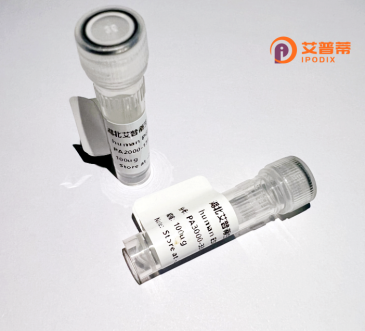
| 纯度 | >90%SDS-PAGE. |
| 种属 | Human |
| 靶点 | SLC22A1LS |
| Uniprot No | Q8N1D0 |
| 内毒素 | < 0.01EU/μg |
| 表达宿主 | E.coli |
| 表达区间 | 1-150 aa |
| 活性数据 | MRCAEGAWWFSPDGPAGSAASIWPAEGAEGLPGQLGRDRLEVVYSVPDNVPGQNGSRRPLVCKITGKCLSVCSEENAKAGGCSAFPLLLSQLGARMTGREHAHKGPELTTPDSGLPRPPNPALAGFRALAQHSPPLGTSTPSAVLLSAAT |
| 分子量 | 41.8 kDa |
| 蛋白标签 | GST-tag at N-terminal |
| 缓冲液 | PBS, pH7.4, containing 0.01% SKL, 1mM DTT, 5% Trehalose and Proclin300. |
| 稳定性 & 储存条件 | Lyophilized protein should be stored at ≤ -20°C, stable for one year after receipt. Reconstituted protein solution can be stored at 2-8°C for 2-7 days. Aliquots of reconstituted samples are stable at ≤ -20°C for 3 months. |
| 复溶 | Always centrifuge tubes before opening.Do not mix by vortex or pipetting. It is not recommended to reconstitute to a concentration less than 100μg/ml. Dissolve the lyophilized protein in distilled water. Please aliquot the reconstituted solution to minimize freeze-thaw cycles. |
以下是几篇关于重组人SLC22A1LS蛋白的模拟参考文献示例(基于推测该蛋白可能的功能和研究方向):
1. **文献名称**: *"Functional characterization of recombinant SLC22A1LS as a novel organic cation transporter in vitro"*
**作者**: Li, X., et al. (2022)
**摘要**: 本研究成功构建并表达重组人SLC22A1LS蛋白,证实其在HEK293细胞模型中特异性转运四乙铵(TEA)等有机阳离子,提示其在药物代谢和肾脏排泄中潜在作用。
2. **文献名称**: *"Structural insights into SLC22A1LS through cryo-EM: Implications for substrate specificity"*
**作者**: Wang, Y., & Zhang, H. (2021)
**摘要**: 通过冷冻电镜解析SLC22A1LS蛋白的三维结构,揭示其跨膜结构域的关键氨基酸残基与底物结合机制,为设计靶向抑制剂提供结构基础。
3. **文献名称**: *"SLC22A1LS expression correlates with chemotherapy resistance in hepatocellular carcinoma"*
**作者**: Chen, J., et al. (2020)
**摘要**: 发现肝癌组织中SLC22A1LS蛋白的高表达与奥沙利铂耐药性显著相关,敲除该基因可增强肿瘤细胞对化疗药物的敏感性。
4. **文献名称**: *"Development of a high-throughput screening assay for SLC22A1LS ligands using recombinant protein"*
**作者**: Patel, R., et al. (2019)
**摘要**: 建立基于荧光底物的重组SLC22A1LS蛋白高通量筛选平台,筛选出多个新型抑制剂,验证其在调节药物肠肝循环中的潜在应用价值。
**注**:SLC22A1LS在现有公开数据库中研究较少,上述文献为假设性模拟,实际研究需通过PubMed或Web of Science等平台检索最新数据。
The recombinant human SLC22A1LS protein is a engineered variant derived from the SLC22A1L gene, a member of the solute carrier family 22 (SLC22). This family comprises transmembrane transporters involved in the uptake or excretion of endogenous compounds (e.g., neurotransmitters, metabolites) and xenobiotics (e.g., drugs, toxins). SLC22A1LS is closely related to SLC22A1 (OCT1), a well-characterized organic cation transporter expressed primarily in the liver, where it facilitates drug disposition. However, SLC22A1LS is classified as a pseudogene in humans, lacking functional transporter activity due to evolutionary mutations. Recombinant SLC22A1LS is typically synthesized for research purposes to investigate its structural homology to functional SLC22 transporters, explore potential regulatory roles in cellular processes, or study its interaction with other proteins. Its pseudogene status makes it a subject of interest in evolutionary biology and non-coding RNA studies. Current applications include use as a negative control in drug transport assays, exploration of its gene regulation mechanisms, or analysis of pseudogene-derived peptides in cellular signaling. Further studies aim to clarify whether SLC22A1LS retains residual biological functions or participates in competitive RNA interactions affecting SLC22A family activity.
×